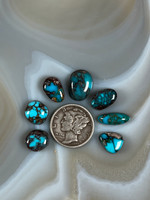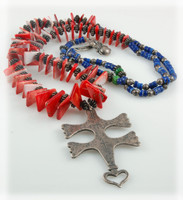 Loading... Please wait...
Loading... Please wait...- 970-375-2401
- Gift Certificates
- My Account
Currency Displayed in
- Home
- Learning Center
- Native American Facts and Native American Jewelry Information
- Native American Jewelry
- Navajo - Native American History
Navajo - Native American History
Categories
Navajo - Native American History
Navajo - Native American History
Navajo Jewelry & Navajo Artists Information
A History of Native American Jewelry made by Navajo Artists
Some say that thoughtful man began with adornment, with the first bead on a necklace to be precise. The thing that seperates man from animal is adornment! According to archaeologists, fetishes of stone and shell predate the Christian epoch; excavations in southern Arizona have produced turquoise dating back to 200B.C.; in South America, as early as 900B.C. Turquoise has and continues to be a standard of “Indian Jewelry.” It would be hard to imagine Native American Jewelry without the Skystone.
One story says, the Ancient Native Americans believed turquoise to be pieces of the sky. Prehistoric Indians mined turquoise for adornment purposes -primarily drilled turquoise beads and ornaments. It has been found in ancient appliqué on shell and other rock suggesting it’s use with wood to create jewelry. From Chaco Canyon to east Mississippi, Native American turquoise jewelry originating from New Mexico’s Cerillos Turquoise mining area has been excavated; likewise for turquoise mined from the Kingman, Morenci, and Conejos areas. Like
The Navajo entered the Southwest in the (some say ‘recent’) 14th-16th century. The Navajo were a nomadic society. “They not only raided, but took, kept, and developed whatever suited them.” (Anderson) Beaded necklaces (a symbol of prestige), decorated ‘ketoh’ (bow guards), and concha/concho ornamentation likely originated from their most frequent conquests, the Spanish and the Pueblo. From the Spanish, the Navajo grew to appreciate adornment.
The Navajo wore adornments acquired from conquest and trade made of German silver, brass, copper and to a lesser extent, silver. Much from Mexican silversmiths, the Spanish and Native neighbors. This Navajo jewelry was worn for beauty and pride- the wearing of a crescent or cross did not necessarily symbolize a respect for Christianity or the Moorish influence on Spain. What began with simple rawhide and pedants, later gave way to stone, shell, silver and other metal beads and intricate ornaments.
Experts in the area seem to agree that Atsidi Sani (“Old Smith”) was the first Navajo silversmith. Learning skills as a blacksmith first, he may have begun silversmithing as early as 1860. In 1864, approximately 8,000 Navajo were captured and “marched into captivity” at Fort Sumner in eastern New Mexico. In 1868, they were returned to the Four Corners area, the Dinehtah. It is argued
Either way, “it is fairly certain that there was no indigenous Navajo or Pueblo silver industry.” Early Navajo silversmiths melted down silver coins, candlesticks and the likes for their work. Mexican currency was the easiest to work (.90275 fine) and special orders that brought sterling silver wares -teapots, candlesticks, household antiques- (.9025 fine) were the next most desirable for use. U.S. coins were the least desirable to work with, (.900 fine) and by 1890 illegal to melt down. Early Navajo silver work focused on concha (concho) belts, bracelets, bow guards, tobacco flasks and necklaces. Rings, earrings, pins, hair ornaments, buckles and bolos evolved from these. A full line of jewelry spread throughout the Navajo reservation by the 1880’s. The oldest work was predominately of hammered and filed decorations; turquoise appeared in Navajo jewelry by 1880. (Anderson)
Shortly after Atsidi Sani began silversmithing, he taught his sons and the craft spread across the area. Zuni silver work appeared around 1872. The Zuni, already skilled metal-workers and lapidaries, supposedly paid “one good horse” for the silver teachings of Atsidi Chon. Incorporating their earlier skills, Zuni silver work took on the fine and channel inlay we now associate with their jewelry. Lanyade, considered the first Zuni silversmith, traveled to various pueblos selling his jewelry. While on Hopi First Mesa at Sichomovi, he taught Sikyatala, the first Hopi silversmith, the craft. Because of the way silversmithing skills were shared, all of the jewelry from this time period is in the Navajo style.
During this time period, different techniques were learned and developed. Soldering (the permanent attaching of two or more pieces of metal) allowed for artistic design and the setting of stones into the jewelry. Silver dies were adopted from the Spanish, Mexican and later Indian leather work. With advancements in technique, the different pueblos and artists began to diverge and refine their unique styles. The Hopi change was more intentional, when the Museum of Northern Arizona in Flagstaff, Az. working with Paul Saufkie and Fred Kabote began a program to develop a unique Hopi style. With a bit of time, they developed the “overlay” technique that pulled designs from pottery shards found in 15th and 16th century ruins to inspire their silver-layering work. These works showed primarily kachinas, animal and clan motifs.
Today’s Native American Navajo jewelry includes silver, beads, gold and stones. Tribal designs, Spanish designs, old style and contemporary design all combine to transcend old styles. From homes on the reservations to museums and art galleries, Indian jewelry is collected and cherished as a connection between historic tradition and contemporary culture.
Information compiled from from Lee Anderson, John Adair, Carl Rosnek and Joseph Stacy, Margery Bedinger, and Larry Frank and the Encyclopedia Britannica. Thank you to all who have continued the stories and provided the information for this history. If you have additional information to offer that you feel is an important and missing piece of this story, please feel free to send it our way.












